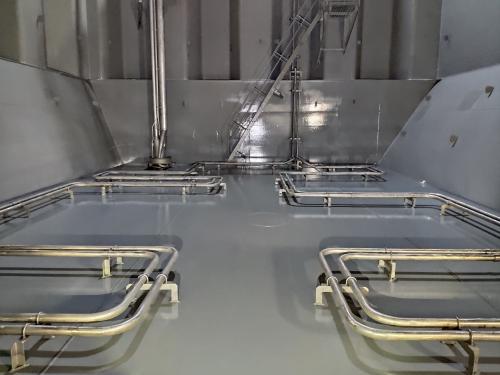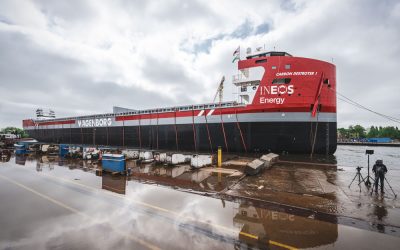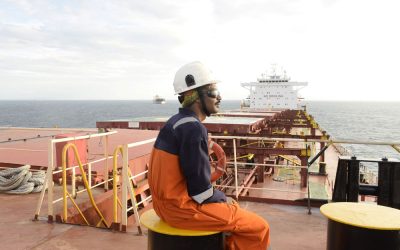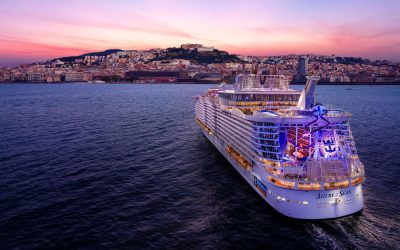The maritime industry is hyper-efficient, and generally there is the opportunity either to improve profitability or to reduce CO2 emissions. In the vanishing number of cases where there is both, shipowners have generally availed themselves of the benefits already. An exception might be sails, which are expected to be relatively affordable, and can offset fuel consumption by double-digit percentages in some cases.
But the peculiarities of operating certain specific ship types still provide opportunities for a decisive saving. Product and chemical tankers provide one example. In this segment, the vessels must undergo intervals of intensive cleaning; it is inevitable that some small amount of the cargo, in constant contact with the wall of the ship’s tanks, will absorb into it, and without an interval of cleaning in between, residues from the previous shipment will go on to contaminate the next. Besides this, a tank coating with absorbed residues from hundreds of different cargoes would be an environmental liability.
Tank-cleaning consists of blasting the tank wall with hot water, sometimes with cleaning chemicals added. The water containing the residues from this process, ‘slop’, is stored in a special tank on board the vessel, later to be discharged at a port receiving facility along with other effluents.
This process requires gargantuan volumes of hot water, and this in turn necessitates a massive amount of heating, which can only be performed in-situ. The ship cannot transport anything during its cleaning interval, but it must continue to run its engines as though it is, in order to generate the huge amounts of hot water required for cleaning. It takes 4,200 joules of energy to heat one kilogramme of hot water by 1°C; producing enough hot water to clean a tank requires unfathomable amounts of energy, all drawn from the vessel’s engines and supply of bunker fuel – with considerable efficiency losses, naturally.
With a zinc-coated vessel, typical in the MR segment, crews can be expected to spend 56 hours, on average, hosing off tanks with hot water after each voyage. This means 64 hours’ of labour, 56 of them using bunker fuel to generate hot water, and 56 hours of emitting CO2 – sometimes more. On an annual scale, this means close three weeks out of every year is spent blasting CO2 into the atmosphere, all while not going anywhere, not transporting anything, nor performing any of the functions for which the ship was built.
The cost of underinvestment
But that is not the end of owners’ problems. Because of the dangers of cargo cross-contamination, shipments have to be rotated in a special order to compensate. If the right sort of cargo isn’t available – tough luck. The effect on owners’ bottom line varies too much on a case-by-case basis to be calculable, but it would be foolish to assume this lack of versatility is not having an impact.
Cheap coatings are certainly available for ship tanks; the aforementioned zinc is a popular choice; phenol epoxy coatings are another. They certainly propose one way of saving on capex for yards, and to some extent for owners. That is, at least, unless they go catastrophically wrong, and generate millions of dollars in repair and recoating costs.
Advanced Polymer Coatings’ (APC) president David Keehan ought to know, as his company is routinely called in to repair these types of applications, which require patches and recoats of varying degrees of extravagance – and in some cases, a full reapplication from scratch. “We are not a generalist paint company attempting to coat the entire ship,” he tells The Naval Architect. “That model is becoming less appealing, as operators are now much more aware that when tank coatings go wrong it can cost millions of dollars per ship to repair, plus disruption and lack of availability.
“We do a lot of recoats. A lot of the time it’s not necessarily even that the previous coating failed, per se – it might simply be a case of underperforming compared with charterers’ expectations. We don’t have to wait for some big catastrophic failure for the savings to be worth having.”
APC’s coating, MarineLINE, has been formulated to be less permeable than zinc, modified epoxies, and other tank coatings. On a microscopic level, it is possible to see this: using high-magnification images taken by the Scientific and Technological Research Council of Turkey, in Ankara, the comparative roughness and uneven surface of the phenol epoxy coating becomes more apparent. Ultimately, an uneven surface has a greater surface area than an even one, providing more for the chemicals to stick to – but it also leaves gaps for these undesired residues to seep into. Once the tank is emptied and the pressure evened out, the coating begins to sweat these residues out, in a process known as ‘desorption’ – but this can take several days.
But the more even surface of the MarineLINE high functionality polymer coating absorbs less of the cargo, and there is much less to be cleaned out. According to findings drawn from over 500 applications, it takes around 16 hours to clean an APC coating, a fraction of the time for a typical zinc or modified epoxy coating. The difference is stark: instead of incurring about three weeks of off hire time for tank cleaning, a ship operator can reduce this interval to as little as a week.
This is more than theory. Rather than relying on laboratory tests under ideal conditions, APC has made its calculations based on real-world findings, given by third parties – specifically, Guy Johnson, owner of L&I Maritime Ltd, MarinSpec Associates, who is himself drawing on findings from over 1,000 cases.
APC global marine manager Onur Yildirim says: “Obviously, we knew our coating would perform better because that’s what we designed it to do, but in terms of our calculations, we based them on the data Guy Johnson has given us.
“On average a vessel consumes 0.6 tonnes per hour of fuel oil in the boiler during tank cleaning. Let’s assume the vessel has 16 cargo tanks, four of which can be cleaned simultaneously. For a zinc silicate coating, you will also need 200L of cleaning chemicals for each tank, which typically costs around $3 per litre – MarineLINE does not require cleaning chemicals, depending on the cargoes.
“So, compared with a zinc silicate coating, we can say that cleaning time will be reduced by 48 hours, during which time, 44 hours of hot water washing will be saved. That equates to 26.4 tonnes of fuel. There will also be a saving in the cost of cleaning chemicals.
“If we assume the vessel makes $18,000 per day, typical for this sort of tanker, you’re looking at a $36,000 saving in terms of off hire time. But in this example, you’ll also be looking at a saving of 86.3 tonnes of CO2 – about three percent of the ship’s annual emissions.”
If CO2 savings are to be made, it is beyond question that the best time to make them is during these cleaning intervals, when the ship is not working. But there are other benefits too.
Changing it up
Each chemical tanker has a smaller tank for the cleaning effluent or ‘slop’. But APC has found that with no slop to be stored, additional cargo can be carried in this tank, and sometimes is, providing a small but decisive bonus to profitability. But there is more than one way in which MarineLINE improves vessels’ versatility and earning potential.
“What we mean by versatility is: MarineLINE’s resistance to absorption makes it possible for owners to switch cargoes more frequently,” explains Mr Yildirim. “A typical MR can be expected to carry 85 different chemicals in a year.
Now recently, we’ve seen charterers making longer agreements, and that makes it less likely that MRs are going to be changing cargoes very often. But anyone who has been paying attention recently will have seen what happened with containers – there were so many ships locked up in long-term charters that the ones available for spot charters made a killing — owners bought them up and made their money back in weeks.
“This can happen in any sector, and there aren’t many MRs to go around – certainly, not that many on spot. So, as you can see, equipping a ship with versatility to carry nearly any cargo at any time is not only a general advantage – but, if the circumstances are right, it can improve the profitability of the vessel.”
Future-proof
Shipping is currently facing up to the reality that decarbonisation will only be possible with the use of new zero-carbon or carbon-neutral fuels, and the cost of these is liable to be several times the price of today’s fossil fuels. It is here that tank coatings can play their role in helping cut emissions, fuel use and costs and when set against an interval of time in which no revenue is earned, the benefits start to become much more pronounced.
The main benefit of having a proper tank coating, however – and the main factor in providing a return on investment greater than 500 percent over the coating’s lifespan, with up to 10 years, or more, proving quite feasible, as well, is cutting cleaning intervals, reducing off-hire time, and getting MRs back to what they do best.






